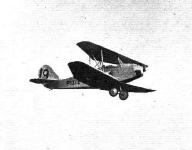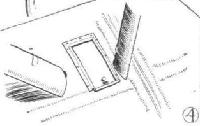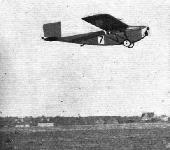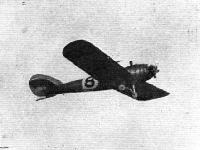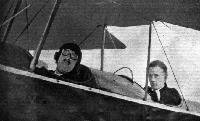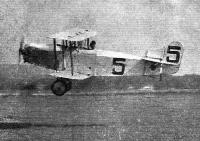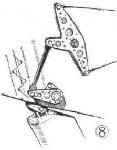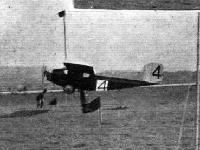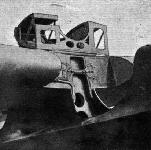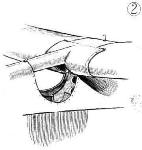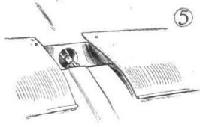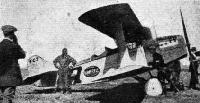Фотографии
-
Регистрационный номер: G-EBJR THE D.H.9 SEAPLANE: Four views of the D.H.9 (230 h.p. Siddeley Puma engine) with which trials were recently carried out with the object of producing a suitable float undercarriage for use on the D.H.50 biplane. There is considerable demand for a seaplane of this type for use in the Colonies.
Самолёты на фотографии: De Havilland D.H.9 - Великобритания - 1917
-
Регистрационный номер: N9777 AN INCIDENT IN THE KINGS CUP RACE. Two views of the Fairey III-D seaplane (450 h.p. Napier "Lion" engine) at Stranraer, on the occasion of the last King's Cup Race, August 12. Above, bringing the seaplane ashore. Below, the crowd watching the refueling operations - note the "Shells" on the shore.
Самолёты на фотографии: Fairey Fairey III - Великобритания - 1917
-
SOME MACHINES AT THE DAYTON INTERNATIONAL AIR RACES: The "Canuck," also with clipped wings.
Самолёты на фотографии: Curtiss JN-4 Jenny - США - 1916
-
Регистрационный номер: G-EBKK [2] TAKE-OFF AND PULL-UP TESTS AT LYMPNE: 1, Wheeling Longton's Hawker "Cygnet I" and Douglas's Parnall "Pixie IIIa " back for the take-off tests.
Самолёты на фотографии: Hawker Cygnet - Великобритания - 1924Parnall Pixie - Великобритания - 1923
-
Регистрационный номер: G-EBJG Pixie IIIA in biplane configuration and flown in 1924 at Lympne. In the official races it was flown in monoplane form still as No.18. This machine is fitted with a Bristol "Cherub."
Pixie IIIA G-EBJG, flown at the 1924 Lympne Trials by Flt Lt R. A. de Haga Haig. Aircraft retired with engine trouble.Самолёты на фотографии: Parnall Pixie - Великобритания - 1923
-
Регистрационный номер: G-EBKK [2] The Second Parnall "Pixie III" mono-biplane, No. 19, in flight.
Самолёты на фотографии: Parnall Pixie - Великобритания - 1923
-
THE LIGHT 'PLANE RACE FOR THE GROSVENOR CHALLENGE CUP: 3 shows the machines lined up for the race
Самолёты на фотографии: Parnall Pixie - Великобритания - 1923
-
THE LIGHT 'PLANE RACE FOR THE GROSVENOR CHALLENGE CUP: 4 shows Douglas on the Parnall " Pixie IIIa";
Самолёты на фотографии: Parnall Pixie - Великобритания - 1923
-
CONSTRUCTIONAL DETAILS OF LIGHT 'PLANES AT LYMPNE: (4) Mounting of Bristol "Cherub" in Parnall "Pixie IIIa."
Самолёты на фотографии: Parnall Pixie - Великобритания - 1923
-
SOME MORE CONSTRUCTIONAL DETAILS FROM LYMPNE: (4) Inspection door and steel attachments on lower starboard wing of Parnall "Pixie IIIa."
Самолёты на фотографии: Parnall Pixie - Великобритания - 1923
-
SOME MORE CONSTRUCTIONAL DETAILS FROM LYMPNE: (7) Wing bracing strut quick-release on Parnall "Pixie IIIa." The small tubular strut runs to root of lower front spar.
Самолёты на фотографии: Parnall Pixie - Великобритания - 1923
-
SOME MACHINES AT THE DAYTON INTERNATIONAL AIR RACES: The Special C.6 Curtiss "Oriole," with clipped wings
Самолёты на фотографии: Curtiss Oriole / Type 17 - США - 1919
-
THE STOUT "AIR PULLMAN": The machine is shown in flight
Самолёты на фотографии: Stout 2-AT Air Pullman - США - 1924
-
THE STOUT AIR PULLMAN: An all-metal commercial aeroplane built in America. It is fitted with a 400 h.p. "Liberty" engine.
Самолёты на фотографии: Stout 2-AT Air Pullman - США - 1924
-
THE STOUT "AIR PULLMAN": An interior view of the cabin.
Самолёты на фотографии: Stout 2-AT Air Pullman - США - 1924
-
TOO LATE FOR LYMPNE: The Blackburn "Bluebird" with Blackburne engine was not finished in time to take part in the recent two-seater light 'plane competitions.
Самолёты на фотографии: Blackburn Bluebird / L.1 - Великобритания - 1924
-
Регистрационный номер: G-EBKA DIGNITY AND IMPUDENCE; or, the long and the "Short" of it; A study in contrasts. The small twin-engined Short light flying boat under the wing of an F.5; the smaller machine is to be tested this week.
Самолёты на фотографии: Felixstowe F.2 - F.5 - Великобритания - 1917Short Stellite / Cockle / S.1 - Великобритания - 1924
-
AT THE LYMPNE LIGHT 'PLANE TRIALS: Lord Ed. Grosvenor (right) and Mr. W. H. Longton, discussing prospects.
Самолёты на фотографии: Hawker Cygnet - Великобритания - 1924
-
Raynham, on the Hawker biplane, flying at Lympne.
Самолёты на фотографии: Hawker Cygnet - Великобритания - 1924
-
TAKE-OFF AND PULL-UP TESTS AT LYMPNE: 4, Raynham making a landing on the Hawker "Cygnet II."
Самолёты на фотографии: Hawker Cygnet - Великобритания - 1924
-
LOW-SPEED FLYING AT LYMPNE: 5, Raynham on the Hawker "Cygnet II."
Самолёты на фотографии: Hawker Cygnet - Великобритания - 1924
-
SOME MORE CONSTRUCTIONAL DETAILS FROM LYMPNE: (3) Bottom plane attachment to wing roots on Sopwith-Hawker "Cygnets." The wing roots are covered with aluminium.
Самолёты на фотографии: Hawker Cygnet - Великобритания - 1924
-
Регистрационный номер: G-EBIM The D.H.51 was much in evidence at Lympne piloted by Mr. Barnard, and took up a number of distinguished passengers.
Самолёты на фотографии: De Havilland D.H.51 - Великобритания - 1924
-
Регистрационный номер: G-EBHX THE LIGHT 'PLANE RACE FOR THE GROSVENOR CHALLENGE CUP: In 7 Cobham is seen standing the de Havilland 53 on its wing tip while rounding the aerodrome turning point.
Самолёты на фотографии: De Havilland Humming Bird / D.H.53 - Великобритания - 1923
-
SOME MORE CONSTRUCTIONAL DETAILS FROM LYMPNE: (2) Spar and flap hinges on Vickers "Vagabond." Note the joint in the fuselage which allows of setting the angle of the rear portion.
Самолёты на фотографии: Vickers Vagabond - Великобритания - 1924
-
Регистрационный номер: G-EBJK THE LIGHT 'PLANE COMPETITION, LYMPNE: The crowd is interested in the tuning-up of some of the machines.
Самолёты на фотографии: Bristol Brownie / Type 91 - Великобритания - 1924
-
LOW-SPEED FLYING AT LYMPNE: 1, Uwins on the Bristol "Brownie." Sir Geoffrey Salmond in the foreground.
Самолёты на фотографии: Bristol Brownie / Type 91 - Великобритания - 1924
-
The Bristol "Brownie" monoplane, No.2, heads for the starting line at Lympne. The best get-off in 1924 was made by the Bristol "Brownie," with Bristol "Cherub" engine, piloted by Cyril Uwins.
Самолёты на фотографии: Bristol Brownie / Type 91 - Великобритания - 1924
-
A FEW UNORTHODOX TAIL SKIDS ON LYMPNE MACHINES: The Bristol is a leaf-spring and the Avro a bent tube. The Short has a long straight, tubular skid, and the Westlands a horizontal Vee with compression spring to the stern-post.
Самолёты на фотографии: Avro Avis / Type 562 - Великобритания - 1924Bristol Brownie / Type 91 - Великобритания - 1924Short Satellite / S.4 - Великобритания - 1924Westland Wood Pigeon - Великобритания - 1924
-
CONSTRUCTIONAL DETAILS OF LIGHT 'PLANES AT LYMPNE: (6) Under carriage of Bristol "Brownie"
Самолёты на фотографии: Bristol Brownie / Type 91 - Великобритания - 1924
-
SOME MORE CONSTRUCTIONAL DETAILS FROM LYMPNE: (6) Locking-pin arrangement on rear spar of Bristol "Brownie."
Самолёты на фотографии: Bristol Brownie / Type 91 - Великобритания - 1924
-
The Glenn Martin Model 70 Commercial biplane, a cargo or passenger machine fitted with a 200 h.p. Wright Model E.4 engine.
Самолёты на фотографии: Martin N2M / Model 70 Commercial - США - 1923
-
THE DAYTON INTERNATIONAL AIR RACES. The principal event of this big American three-day aviation meeting was the speed contest for the Pulitzer Trophy. Above is a front view of the 1922 Verville-Sperry (500 h.p. Curtiss D-12) cantilever monoplane which won this year's race with a speed of 215-72 m.p.h.
Самолёты на фотографии: Verville Verville-Sperry Racer / R-3 - США - 1922
-
AT LYMPNE: The A.N.E.C. II monoplane well away on a test flight.
Самолёты на фотографии: ANEC I / II - Великобритания - 1923
-
Регистрационный номер: G-EBHS THE LIGHT 'PLANE RACE FOR THE GROSVENOR CHALLENGE CUP: 5, Bulman rounding the aerodrome tent on the Farnborough "Hurricane";
Самолёты на фотографии: RAE Hurricane - Великобритания - 1923
-
SOME MACHINES AT THE DAYTON INTERNATIONAL AIR RACES: The "New Swallow"
Самолёты на фотографии: Swallow New Swallow - США - 1924
-
SOME MACHINES AT THE DAYTON INTERNATIONAL AIR RACES: The racing "Swallow."
Самолёты на фотографии: Swallow New Swallow - США - 1924
-
The Short "Satellite" monoplane, making a trial flight at Lympne.
Самолёты на фотографии: Short Satellite / S.4 - Великобритания - 1924
-
General Sir Sefton Brancker looks thoroughly pleased after a flight with Capt. Biard in the Supermarine "Sparrow."
Самолёты на фотографии: Supermarine Sparrow - Великобритания - 1924
-
SOME MORE CONSTRUCTIONAL DETAILS FROM LYMPNE: (1) Hinge on lower rear spar for folding wings of Supermarine "Sparrow."
Самолёты на фотографии: Supermarine Sparrow - Великобритания - 1924
-
Running-up the engine of No. 5, the Westland "Wood Pigeon."
Самолёты на фотографии: Westland Wood Pigeon - Великобритания - 1924
-
LOW-SPEED FLYING AT LYMPNE: 4, Gaskell on the Westland "Wood Pigeon"
Самолёты на фотографии: Westland Wood Pigeon - Великобритания - 1924
-
SOME MORE CONSTRUCTIONAL DETAILS FROM LYMPNE: (8) External elevator cranks on Westland "Wood Pigeon." Sketch also shows front chassis strut attachment.
Самолёты на фотографии: Westland Wood Pigeon - Великобритания - 1924
-
Регистрационный номер: G-EBJJ [4], VH-URJ [4] THE WINNER: The Beardmore "Wee Bee I," Bristol "Cherub" engine, on which Piercey won first prize in the Lympne Light 'Plane competitions.
Самолёты на фотографии: Beardmore W.B.XXIV Wee Bee - Великобритания - 1924
-
Регистрационный номер: G-EBJJ [4], VH-URJ [4] LOW-SPEED FLYING AT LYMPNE: 3, Piercey on the Beardmore "Wee Bee."
Самолёты на фотографии: Beardmore W.B.XXIV Wee Bee - Великобритания - 1924
-
Регистрационный номер: G-EBJJ [4], VH-URJ [4] The Beardmore "Wee Bee" monoplane (Bristol "Cherub") taking off in the eliminating trials at Lympne.
Самолёты на фотографии: Beardmore W.B.XXIV Wee Bee - Великобритания - 1924
-
Регистрационный номер: G-EBJJ [4], VH-URJ [4] The "Office" of the Beardmore "Wee Bee I" is reached by hinging back the central portion of the leading edge, as shown in this photograph.
Самолёты на фотографии: Beardmore W.B.XXIV Wee Bee - Великобритания - 1924
-
CONSTRUCTIONAL DETAILS OF LIGHT 'PLANES AT LYMPNE: (2) Front cockpit covering of Beardmore "Wee Bee I." Leading edge and top cover hinge back for getting into and out of cockpit.
Самолёты на фотографии: Beardmore W.B.XXIV Wee Bee - Великобритания - 1924
-
CONSTRUCTIONAL DETAILS OF LIGHT 'PLANES AT LYMPNE: (5) View into rear cockpit of Beardmore "Wee Bee I," showing spar attachment to top of fuselage This cockpit is covered by a hinged window of celluloid.
Самолёты на фотографии: Beardmore W.B.XXIV Wee Bee - Великобритания - 1924
-
SOME MORE CONSTRUCTIONAL DETAILS FROM LYMPNE: (5) The aileron gap in the "Wee Bee I" is covered with aluminium strips. The aileron is hinged at bottom edge, and is operated direct from upper edge by a pull-and-push rod.
Самолёты на фотографии: Beardmore W.B.XXIV Wee Bee - Великобритания - 1924
-
The Light 'Plane Competition, Lympne: The "Cranwell" biplane (Bristol "Cherub"), built by the Cranwell Light Plane Club, starting for a test flight.
Самолёты на фотографии: Comper Cranwell II / CLA.2 - Великобритания - 1924
-
Регистрационный номер: G-EBKP [3] THE LIGHT 'PLANE RACE FOR THE GROSVENOR CHALLENGE CUP: 1 shows the winner, Bert Hinkler, on the Avro "Avis" (Bristol "Cherub"), starting off in the race
Самолёты на фотографии: Avro Avis / Type 562 - Великобритания - 1924
-
Регистрационный номер: G-EBKP [3] The Avro "Avis" has difficulty in getting "unstuck."
Самолёты на фотографии: Avro Avis / Type 562 - Великобритания - 1924
-
Регистрационный номер: G-EBKP [3] THE LIGHT 'PLANE RACE FOR THE GROSVENOR CHALLENGE CUP: The winner, Bert Hinkler, on the Avro "Avis" (Bristol "Cherub"), crossing the finishing-line first.
Самолёты на фотографии: Avro Avis / Type 562 - Великобритания - 1924
-
CONSTRUCTIONAL DETAILS OF LIGHT 'PLANES AT LYMPNE: (1) Mounting for Bristol Cherub on Avro "Avis"
Самолёты на фотографии: Avro Avis / Type 562 - Великобритания - 1924
-
CONSTRUCTIONAL DETAILS OF LIGHT 'PLANES AT LYMPNE: (3) Rudder and elevator hinges on Avro "Avis." The elevator gap is afterwards covered with fabric strip.
Самолёты на фотографии: Avro Avis / Type 562 - Великобритания - 1924
-
THE NIEUPORT-DELAGE TYPE 38 BIPLANE: A Service Machine which can be used either as a school machine or for aerial photographic work, etc. By means of an interchangeable body, this machine can also be used for commercial work, carrying two passengers. It is fitted with a 190 h.p. Renault, or 180 h p Hispano-Suiza engine. The main characteristics are: Span, 11-1 m. (36 ft. 5 ins.); length, 8 m (26 ft. 3 ins.); chord, 1-8 m. (6 ft. 0 in.); gap, 2 m. (6 ft. 6 ins.); wing area, 37-8 sq.m. (406-7 sq. ft.); weight empty. 850 kg. (1,874 lbs.); weight loaded 1,250 kg. (2,756 lbs.); weight per h.p., 6.25 kg. (13.8 lbs.); wing loading, 33-1 kg./m2. (6-75 lbs./sq. ft.); speed, 175 km.p.h. (108-75 m.p.h.; climb 1.000 m. (3,280. ft.) 8 mins. 35 secs., 3,000 m. (10,000 ft.), 36 mins. 45 secs.; ceiling, 4,000 m. (13,120 ft.).
Самолёты на фотографии: Nieuport-Delage Ni-D-38 / Ni-D-39 - Франция - 1924
-
SOME MACHINES AT THE DAYTON INTERNATIONAL AIR RACES: The Hartzell FC-1
Самолёты на фотографии: Hartzell FC-1 - США - 1923
Статьи
- Flight





